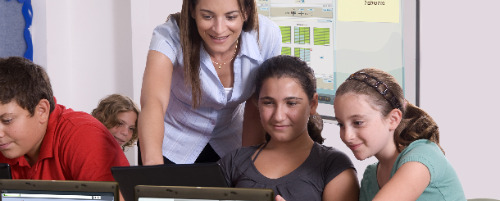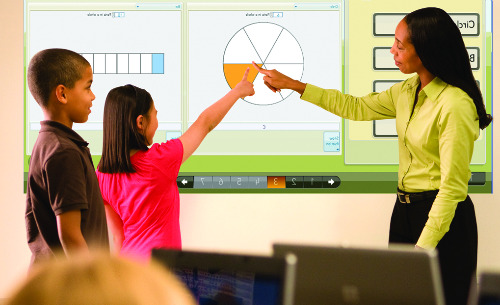With a computer on every desk and a holistic approach to learning, performance and motivation are soaring in ‘Time to Know’ classrooms in both Israel and the US.

Moshe of Tel Aviv’s underprivileged Hatikva Quarter used to dread returning to school in the fall. He anticipated another year of dull instruction, lugging boring textbooks and feeling alienated from his classmates and his teacher. Indeed, school was a turn-off he often skipped altogether – but that was before the revolution. That was before classroom hardware from Israeli start-up Time to Know reached his school.
The Time to Know revolution began three years ago, in grades four to six, in two Israeli schools. This year, there are 20 schools in the country benefiting from its Recommended Core Curriculum and Digital Teaching Platform -innovations in classroom hardware that transform kids like Moshe from school losers into winners. Also this year, Time to Know is being launched in 26 schools in New York.
Pupil and class performance and motivation soared in the US pilot of the program in Dallas last year, making a believer of New York City Chancellor of Education Joel I. Klein. South Korea and other countries have also expressed interest in the learning system company that the company’s chief pedagogical officer Dovi Weiss believes can fix “the classroom machine that’s broken.”
Current users are hoping for Dallas-like results: Dramatic improvement in writing, reading and math scores. A control group not using the system had 73 percent of the pupils in the class below, or at standard writing skills level, while the Time to Know group had 98% at standard or recommended levels.
No more “chalk and talk”
According to Weiss, teachers haven’t been fully exploiting the computers’ technology and scope in the classroom. But all that changed when Time to Know was launched six years ago by Amdocs billing giant founder Shmuel Meitar, Weiss, Molly Globus and others. They applied a similar “holistic approach” to recreating the classroom learning process as they had used to put Amdocs atop the billing industry.
Four “bugs” were identified in typical classrooms. Most pupils received what Weiss describes as “only chalk and talk” frontal education. “But using only this one way of teaching fits nobody. That’s a bug,” he tells ISRAEL21c. Moreover, one set of teaching materials and standardized tests weren’t sufficient for the 35-plus pupils with varying needs in the typical, overcrowded Israeli classroom.
The next bug, “drill and kill” exercises, managed to kill off any desire for engagement in lessons for kids. Teachers also received little feedback about their pupils beyond a quiz or test score, which was usually too little and too late. And extra help wasn’t easy to come by.
Meitar – credited with the original vision for this classroom revolution – and his team also found that schools failed to provide kids with vital computer skills needed to succeed, another serious problem. “It’s not the teachers but the classrooms that aren’t working,” Weiss says. It was time for a classroom makeover.

Step one was “really integrating technology into the classroom” with a laptop per pupil, a projector, and a special “dashboard style” laptop for the teacher.
The hardware – supplied by municipalities, school districts or other providers – is the first of three pillars that support the program. Once that’s in place, the cost of software is $200 per pupil. “But then we came up with two innovative pillars that actually did not exist in the world,” Weiss continues. First, the “Interactive Core Curriculum” provides entertaining and interactive digital learning activities in all core subjects. Then a Digital Teaching Platform, which Weiss laughingly calls “Windows for teachers,” allows them to plan and conduct a lesson while viewing pupil feedback in real classroom time.
Cool school
On the first day of school this September, some lucky fourth to sixth graders in Israel and New York arrived at school to find laptops on their desks. The teachers clicked “play” and a clever cartoon featuring youngsters racing around a track in a ‘fraction race’ was displayed via the new classroom projector.
The cartoon “hypnotizes” the young audience so there are fewer discipline issues, Weiss explains. “They sit quietly and are very enthusiastic. When the animation stops, the teacher asks a question: Danny is in the lead, but who is number two, number three, etc.? Then the stimulated students submit potential answers to a ‘gallery’ of classroom replies.
As each pupil works on a laptop, it supplies immediate feedback to the teacher. A wrong answer earns a child a hint toward the right one, an educational process called scaffolding. Alerted by her computer that someone needs help, the teacher can quickly provide assistance.
Meanwhile, more advanced students are prompted to explore a section on Egyptian fractions; while those lagging play ‘Fraction Wars’ to practice. An ‘Eyes on the Teacher’ computer alert signals the pupils that the teacher is launching a classroom discussion.
“Very quickly the four bugs are beginning to be solved,” Weiss declares, “The classroom variance is addressed, the pupils are engaged, active, and the teacher is receiving a lot of feedback… the computers are part of the classroom, used in a natural and holistic way.”
Teacher Philia Stewart of the Lancaster Elementary School said of the program: “You can teach a child anything once they’re engaged, because they’re ready to learn, and that’s the difference between a Time to Know classroom and a regular classroom. [The pupils] hate books they have to read. So when you give them a book, they’re already shut off. But when you put technology in front of them they say: ‘Okay, cool, I can do this.’ You can teach them almost anything. I don’t lose any kids when I do Time to Know.”
As Dallas pupil Xavier Seigh puts it: “It’s a cool way of going to school.”
Repair education, repair the world
The Time to Know revolution seems to be working. Indeed, the President’s Conference in Israel chose the company as one of six Israeli firms that can ‘create a better tomorrow’ – the only one in the field of education – and there are plans to expand it to grades six to eight.
Weiss, a graduate of the Mandel Leadership Institute, cites the words of the great educator Janusz Korczak (who chose to die in the Treblinka extermination camp with his pupils) who said: “Repairing the world is repairing education.”
Weiss says: “For me personally, that’s a vision and my mission. I’m proud to be an Israeli who will be able to do something… If we can create a better world, [and] it’s coming from Israel, I think it’s very good for our country.”












